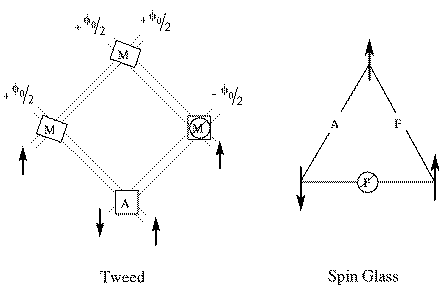
What is tweed? How does it fit into the language of disordered systems? Thinking about the competition between different regions which at a given temperature do or do not want to transform to the deformed martensite phase, we saw a clear analogy to the frustration found in spin glasses. Different regions along the fibers in the tweed pattern had to transform in concert, leading to frustration. We then discovered that this analogy becomes precise in the limit of infinite elastic anisotropy, and that our two dimensional model maps onto the infinite--range bipartite Sherrington--Kirkpatrick spin glass. The antiferromagnetic phase corresponds to austenite; the ferromagnetic phase corresponds to martensite. Tweed is the intermediate spin glass phase! At finite anisotropy in our two dimensional model, tweed becomes the ghost of the spin--glass phase; in three dimensions, there may be a true intermediate glassy phase.

Finally, what explanatory power does our model have for shape memory alloys? One of the most important unexplained features of the shape--memory alloys is the two--way shape memory effect. If one trains the sample a few times, deforming it into a particular configuration as it cools through the transition, eventually it will deform by itself. How does the system remember its low--temperature configuration, in the undeformed high--temperature phase where there are no twin boundaries to hold the information? One thing glassy systems are good for is history dependence! Our models definitely can be trained: heating from deformed martensite into tweed and cooling preferentially returns into the original deformation. A tangible prediction results from this picture: the two--way shape memory effect will disappear if one heats past the tweed regime.
Two cycles under external stress, from
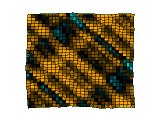 strained tweed to
strained tweed to
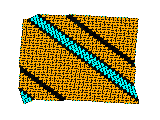 strained martensite and back;
strained martensite and back;
two cycles without external stress from
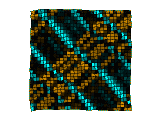 trained tweed to
trained tweed to
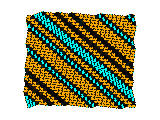 trained martensite and back.
Notice the strain is remembered after the stress is removed!
trained martensite and back.
Notice the strain is remembered after the stress is removed!
![]() James P. Sethna, sethna@lassp.cornell.edu
James P. Sethna, sethna@lassp.cornell.edu
![]() Statistical Mechanics: Entropy, Order Parameters, and Complexity,
now available at
Oxford University Press
(USA,
Europe).
Statistical Mechanics: Entropy, Order Parameters, and Complexity,
now available at
Oxford University Press
(USA,
Europe).